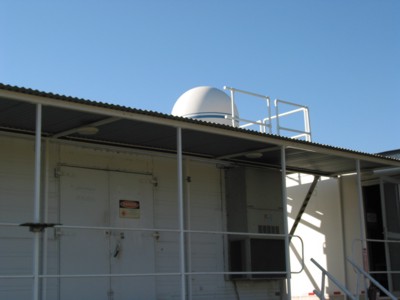Under worst conditions, based on ANSI Z136.1 - 1986 requirements, the MOBLAS laser beams are capable of causing blind spots in unprotected eyes at up to 39 km. Therefore the system has equipment designed to enhance eye safety for operators and other persons. The safety equipment basically consists of:
- the safety interlock and it's peripheral equipment,
- the radar.
The Safety Interlock

Interlock (MRU 2A1)
The interlock is designed to be fail-safe in operation. Tha failure of any any sensor causes it's associated safety device to be activated; the associated filter falls into place and the laser becomes disabled. Failure of the safety interlock causes all safety devices to be activated; all the filters fall into place and the laser becomes disabled. The interlock required conscious action by the operator to clear the beam path and re-enable the laser. The safety interlock consists of the Console Laser Interlock (2A1) and it's peripherals:
- two remote control boxes
- motion sensor
- pressure pads
- mount position sensors
- video camera
The remote control boxes are situated at the mount and in the laser room. When one of the boxes are activated it lights a red LED on the interlock front panel that identifies the source of the disable signal.
The MOMS van roadside has a motion detector that is used to detect and announce movement at the roadside without disabling the laser.
Three pressure pads in the stairwell area disable the laser whenever they detect the presence of a person in the mount area.
The mount position sensor is a pair of micro switches that detect when the mount is above or below 20° elevation. Above 20° the transmit beam is allowed to leave the mount at full power; below 20° the switches cause the 5.8 ND transmit filter to drop in place, reducing the output to Class I power levels.
The video camera is included with the laser interlock to allow the console operator to visually access an alarm and to ascertain whether anybody is at risk.
Radar

Radar Controller (MRU 6A6)
The radar is designed to detect aircraft which are inside the 39 km danger radius, and to turn off the laser while the risk exists. It is designed to search a cone of space that surrounds the laser beam for any aircraft in that cone. All radar returns are subjected to statistical algorithms to determine whether they are from aircraft or spurious noise returns. Aircraft returns causes the radar to disable the laser beam and positive operator action is required to re-enable the laser, providing an extra measure of safety. The radar antenna is slaved to the laser tracking optical mount, and is mounted in a dome on top of the MOMS van as can be seen in the next photo.

Radar Antenna in dome
This page is best viewed in at least Internet Explorer 5, Netscape 4 or Mozilla 1.4 on a resolution of 1024x768. For comments or queries, please contact the SLR webmaster.



